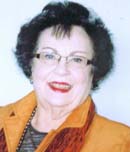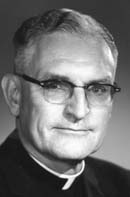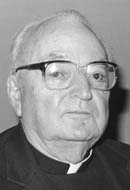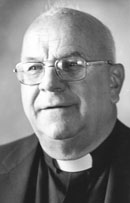By Alta Cook

Recently, The Catholic Messenger reported that the former St. Thomas More Parish Center, 108 McLean St., Iowa City, had been sold to Frantz-Hobart Management of Cedar Rapids, Iowa, for $450,000. This historic Tudor building, originally a Psi Omega dental fraternity house, was purchased for $25,000 under the leadership of Bishop Henry Rohlman in 1942 and became the Catholic Student Center with Father Leonard Brugman as director.
As the number of Catholic students at University of Iowa increased, it became necessary to purchase a building site on Riverside Drive close to the center for erecting a temporary chapel. (Mass had been previously held in the center’s lounge.) The City Council deeded the land between the center and the site, actually a ravine, thus connecting the center with the chapel.
The chapel was a quonset hut with a round dome. (Quonset huts became quite prevalent on campus as WWII veterans returned home). Although a simple structure, The Chapel of St. Thomas More, which opened in 1947, was home to many parishioners who admired the impressive crucifix and also artwork by Father Edward Catich. My husband James and I were married in this same quonset hut chapel Dec. 26, 1964.
When I graduated as salutatorian from Iowa City High School in 1952, I knew college was in my future. The three major job opportunities for women in those days appeared to be nursing, teaching or secretarial work. Teaching won out! Even though the tuition at the University of Iowa was only $78 a semester (shocking to today’s students), I needed to have a job! The Catholic Student Center needed a secretary, so I applied and was hired. Thus began my memorable relationships with the “Five Black Crows” (who used this signature when signing my birthday and Christmas cards.) These gifted priests were Fathers J.D. Conway, Robert Welch, Kenneth Martin, Andrew Barry and Robert Bodenkircher.

Msgr. Conway became St. Thomas More’s pastor and director of the Student Center in 1952. He wrote answers for “The Question Box” in The Messenger (which is still an ongoing column with Father Ken Doyle) and also was the author of a book, “What They Ask About Marriage,” which became quite popular. Monsignor took pride in his work with the utmost integrity and gave sincere compliments when deserved, admitting to me, “This is the first time the books balanced out to the penny!”
As busy as his schedule was (with an increasing number of parishioners, visitors from all over the country, young children attending religious education courses — thanks to the direction of Jean Eckstein) he believed in making house calls when needed. He managed to journey out to a rural setting where he greeted my parents and said a special prayer that I would recover from a nasty bout of tonsillitis and the flu. I always felt he would have made an excellent bishop!
Fr. Welch was the clever and witty Black Crow. His homilies were especially entertaining. He also taught classes at the University of Iowa’s School of Religion.

Many students enrolled in his courses, especially those discussing marriage. He had asked me to do some secretarial work at the school. I agreed and helped type some letters for the Methodist minister and the Jewish professor. Using the correct salutation and vocabulary in those letters could be a little tricky as I was used to Catholic terminology, but I survived.
Needing one more course to graduate, I took his class, “The Catholic Faith,” thinking it shouldn’t be too difficult. However, his final exam consisted of 100 true-false questions! I asked him the next day, “How did I do?” He replied jokingly, “Well you tied for first place with the Protestant minister. I was glad he didn’t beat you out because you are the Catholic.” Fr. Welch sincerely loved being a priest.

Fr. Martin also lived at the parish center in the early ‘50s. He had a difficult but interesting job as hospital chaplain. He was upbeat, friendly, often dropping by the office to just say “hello,” a good conversationalist and listener.
Another Black Crow, Fr. Barry, was a conscientious and sincere priest who was an assistant to Msgr. Conway.

The last Black Crow was a student and a priest, Fr. Bodenkircher, who served as chaplain of the Newman Club. His youth, temperament and general demeanor served his position well. The students liked him.
Four of the Five Black Crows later became pastors with their own parishes. I don’t know what became of Fr. Bodenkircher.
But as I drive past the former St. Thomas More Parish Center — soon to become apartments — memories of the Five Black Crows remain vivid and I want to recapitulate to their spirits: “Well done, gentlemen!” You served your priesthood vocation admirably! May you now enjoy the fruits of your labors with our Blessed Lord!”
(Alta Cook is a retired Iowa City language arts teacher, Golden Apple award winner and inductee into the City High Hall of Fame).









Great article! Mrs. Cook was my drama teacher while I attended Central Junior High School in Iowa City, Iowa. She was one of the first and main teachers to show that she appreciated what I had to offer. She encouraged me to participate in Iowa City’s Oratorical Contest (where I received 3rd).
I think of Mrs. Cook often with great appreciation.